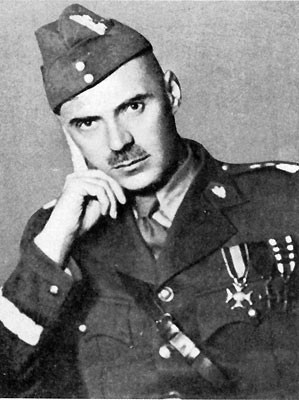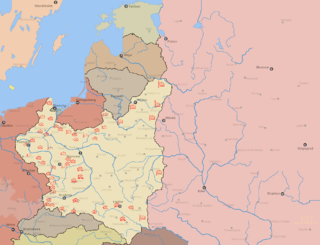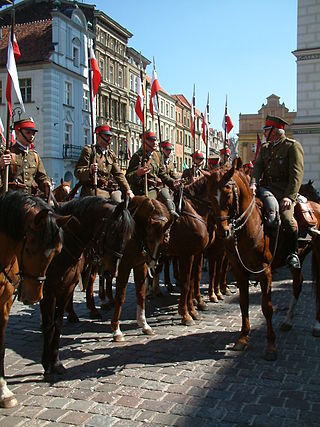
The 2nd Polish Corps, 1943–1947, was a major tactical and operational unit of the Polish Armed Forces in the West during World War II. It was commanded by Lieutenant General Władysław Anders and fought with distinction in the Italian Campaign, in particular at the Battle of Monte Cassino. By the end of 1945, the corps had grown to well over 100,000 soldiers.

This article discusses the Polish order of battle during the invasion of Poland. In the late 1930s Polish headquarters prepared "Plan Zachód", a plan of mobilization of Polish Army in case of war with Germany. Earlier, the Poles did not regard the Germans as their main threat, priority was given to threat from the Soviets.

"My, Pierwsza Brygada", also known as Marsz Pierwszej Brygady and Legiony to żołnierska nuta, is one of the best-known patriotic marches of the Polish Legions formed during World War I by Józef Piłsudski.

The Volhynian Cavalry Brigade was a Polish cavalry brigade, which saw action against the invading Germans during the Invasion of Poland, a part of World War II. Raised from recruits in the area of Wołyń, the division was posted to the Łódź Army. During several desperate counter-attacks, the brigade suffered heavy casualties near Łódź. It was commanded by Colonel Julian Filipowicz. Most notably, the unit took part in one of the first battles of the German invasion of Poland, the battle of Mokra.

The 2nd (Warsaw) Armoured Brigade was an armoured brigade of the Polish Armed Forces in the West during World War II that existed from 1942 to 1945. From 1945 to 1947 it was redesignated as the 2nd Warsaw Armoured Division. The unit was the armoured wing of the 2nd (Polish) Corps. The state of the brigade in the Italian campaign was: 222 officers and 3362 serial. There were 160 medium tanks, 33 light tanks and 13 special tanks.
Carpathian Half-Brigade of National Defence was a unit of the Polish Army in the interbellum period that took part in the Polish September Campaign. It was formed in July 1937 in Stanisławów. Originally, it consisted of two battalions, but in May 1939 it was expanded to four battalions. In the summer of 1939 it became part of the Karpaty Army. Its battalions were:

Modlin Army was one of the Polish armies that were part of the Polish defense against the German Invasion of Poland. After heavy casualties in the battle of Mława, the Army was forced to abandon its positions near Warsaw around September 10; eventually it took part in the battle of Tomaszów Mazowiecki and surrendered afterwards.
Sieradz National Defence Brigade was a reserve unit of the Polish Army in the interbellum period. Stationed in Łódź, on August 30, 1939, it was moved to Wieluń. It consisted of several battalions, such as Wieluń I, Wieluń II, Kępno, Ostrzeszów, Lubliniec and Klobuck. Commanded by colonel Jerzy Grobicki, it was part of the Łódź Army and its battalions were divided between 7th and 10th Infantry Divisions.

Brigade II of the Polish Legions, also known as the Iron or Carpathian Brigade, a unit of Austro-Hungarian Army, manned by Austrian Poles, part of the Polish Legions in World War I, that existed from 1914 or 1915 till 1918.

A Dowództwo Okręgu Korpusu was a military district of the Ministry of Military Affairs of the Second Polish Republic. It served as an organizational, mobilisational, and administrative body of the Polish Army, and all of Poland's local military units were subject to the Corps Commands.

15th Poznań Uhlan Regiment – unit of Polish cavalry, part of Greater Polands Army, Polish Army of Second Republic and Polish Armed Forces in the West during World War II.

The Pomeranian Military District was a military district of the Polish Armed Forces from 1945 to 2011. Formally it was subordinate to the Minister of National Defence in the operational matters of defense and detached government administration. The district command headquarters was at Torun (1945–1946), Bydgoszcz, Gdańsk, Koszalin, and then at Bydgoszcz. From 1947 to 2007 1 Gen. J. Dwernicki Street, from 2007 to December 2011 105th Szubinska Street.

Andrzej Kusionowicz Grodyński, born Andrzej Szymon Kusionowicz, was a Polish lawyer who worked as a Silesian circuit judge based in Cieszyn for much of his career. Kusionowicz was also the editor of Gwiazdka Cieszyńska from 1889 to 1890. An associate of Paweł Stalmach (cs), who founded Gwiazdka Cieszyńska, he was also a friend of Józef Londzin (pl) with whom he shared the early vision of Cieszyn Silesia joining Galicia in a new Polish state independent of Austrian rule.

The Territorial Defence Force – TDF is the fifth military branch of the Polish Armed Forces, following Land Forces, Air Force, Navy and Special Forces. The force is made up of professional and part-time volunteer soldiers, forming part of the country's defence and deterrence system. Formed in 2016, it had reached 24,000 personnel by July 2019, and was slated to reach a size of around 53,000 personnel in 17 light infantry brigades by 2021. The creation of the Polish TDF relates to the reforms in the Baltic states' Territorial Defence Forces to provide response during the early stages of a hybrid conflict.

The Warsaw Garrison Command (WGC) is a stand-alone military unit subordinate to the Ministry of National Defence charged with providing operational, logistic and security support for the Ministry and central command units of the Polish Armed Forces, based in Warsaw military district. Command's units also perform ceremonial duties during state visits, parades, other events and daily provide honour guarding of the Presidential Palace and the Tomb of Unknown Soldier.
Klasa A represents the seventh level of the Polish football hierarchy. Teams promoted from Klasa A move up to the liga okręgowa, whilst relegated teams descend to the Klasa B leagues.
The Polish Air Defence Force - was one of the four branches of the Polish People's Army in the years 1962–1990, along with the Polish Land Forces, Polish Air Force and the Navy.

Stanisław Sylwester Alfonzy Grodyński - Polish soldier, lawyer, local government administrator and senior military intelligence adviser\officer.

1st Podlaska Territorial Defence Brigade named after Brig. Gen. Władysław Liniarski, pseudonym "Mścisław" is a tactical unit of the Territorial Defense Forces of the Polish Armed Forces. It is headquartered in Białystok.